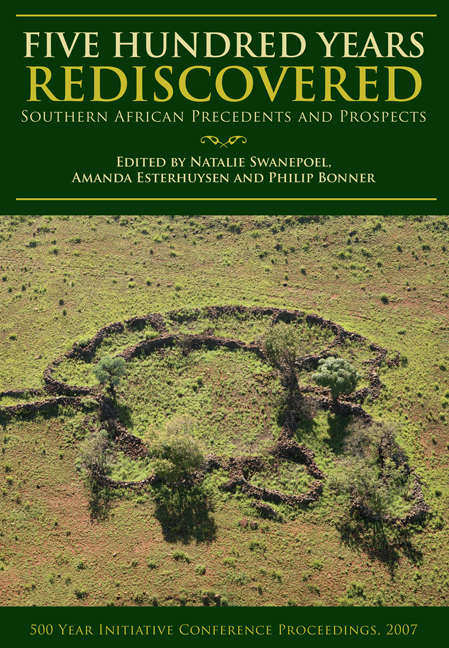Book contents
- Frontmatter
- Contents
- Preface
- 1 Introduction
- Section 1 Disciplinary Identities: Methodological Considerations
- Section 2 Material Identities
- 8 Revisiting Bokoni: populating the stone ruins of the Mpumalanga Escarpment
- 9 The Mpumalanga Escarpment settlements: some answers, many questions
- 10 Post-European contact glass beads from the southern African interior: a tentative look at trade, consumption and identities
- 11 Ceramic alliances: pottery and the history of the Kekana Ndebele in the old Transvaal
- Section 3 ‘Troubled Times’: Warfare, State Formation and Migration in the Interior
- List of contributors
- Index
10 - Post-European contact glass beads from the southern African interior: a tentative look at trade, consumption and identities
from Section 2 - Material Identities
Published online by Cambridge University Press: 30 May 2019
- Frontmatter
- Contents
- Preface
- 1 Introduction
- Section 1 Disciplinary Identities: Methodological Considerations
- Section 2 Material Identities
- 8 Revisiting Bokoni: populating the stone ruins of the Mpumalanga Escarpment
- 9 The Mpumalanga Escarpment settlements: some answers, many questions
- 10 Post-European contact glass beads from the southern African interior: a tentative look at trade, consumption and identities
- 11 Ceramic alliances: pottery and the history of the Kekana Ndebele in the old Transvaal
- Section 3 ‘Troubled Times’: Warfare, State Formation and Migration in the Interior
- List of contributors
- Index
Summary
Introduction
The glass beads that were traded into the interior of southern Africa in the past five hundred years are the most frequently found imported artefacts in archaeological deposits. They have unfortunately been little studied even though they have the potential to help interpret several aspects of archaeological sites where they are present. These include illuminating trade contacts and routes, determining cultural affiliations and refining site chronology. This study includes a brief introduction about using beads in site interpretation and a discussion and interpretation of bead assemblages from four areas in the interior.
Glass bead characteristics
Before discussing the glass beads found in the southern African interior, a few terms used to describe beads should be explained (information from this section was taken from Karklins (1985), and Kidd and Kidd (1970)). Glass beads are first categorised according to their method of manufacture. The methods pertinent to this study include drawing and winding. Drawn beads are made by creating a hollow in a gather (globule) of molten glass either by blowing a bubble into it or perforating it with a tool. (This hollow will remain to form the perforation in the finished bead.) The gather is then drawn or pulled out into a long tube that is next cut into segments the lengths of the desired beads. The resultant segments may then be reheated to round the sharp edges – the length of time this heating process is carried out determines the roundness of each bead. Beads that are not reheated, or are reheated to only a small extent, retain the straight profile of the original tube and are thus called tubes. Beads that are heated until the ends are decidedly rounded but the body retains straight sections are referred to as cylinder, and those reheated to the extent that the entire profile is rounded are known as oblates. Drawn beads may be decorated with stripes or may be composed of more than one layer of glass. Stripes are created by impressing rods of coloured glass on to the exterior of the gather before it is drawn out. Additional layers of glass are made by dipping the gather into molten glass of another colour (or several colours) before being drawn.
- Type
- Chapter
- Information
- Five Hundred Years RediscoveredSouthern African precedents and prospects, pp. 183 - 196Publisher: Wits University PressPrint publication year: 2008



